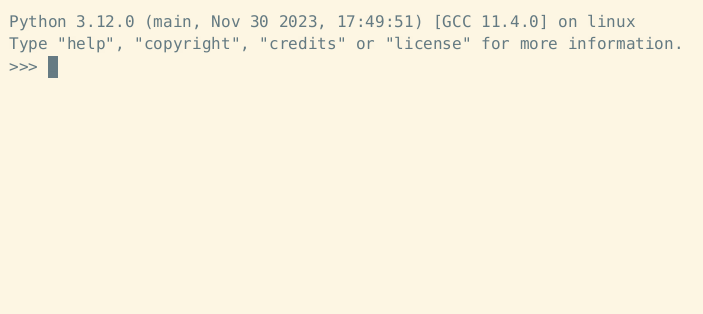The dramatic module includes utilities which cause all text output to display character-by-character (it prints dramatically).
Note: This project is based on a Python Morsels exercise. If you're working on that exercise right now, please don't look at the source code for this! 😉

The dramatic module is available on PyPI.
You can install it with pip:
$ python3 -m pip install dramaticThere are four primary ways to use the utilities in the dramatic module:
- As a context manager that temporarily makes output display dramatically
- As a decorator that temporarily makes output display dramatically
- Using a
dramatic.start()function that makes output display dramatically - Using a
dramatic.printfunction to display specific text dramatically
The dramatic.output context manager will temporarily cause all standard output and standard error to display dramatically:
import dramatic
def main():
print("This function prints")
with dramatic.output:
main()To change the printing speed from the default of 75 characters per second to another value (30 characters per second in this case) use the at_speed method:
import dramatic
def main():
print("This function prints")
with dramatic.output.at_speed(30):
main()Example context manager usage:
The dramatic.output decorator will cause all standard output and standard error to display dramatically while the decorated function is running:
import dramatic
@dramatic.output
def main():
print("This function prints")
main()The at_speed method works as a decorator as well:
import dramatic
@dramatic.output.at_speed(30)
def main():
print("This function prints")
main()Example decorator usage:
Instead of enabling dramatic printing temporarily with a context manager or decorator, the dramatic.start function may be used to enable dramatic printing:
import dramatic
def main():
print("This function prints")
dramatic.start()
main()The speed keyword argument may be used to change the printing speed (in characters per second):
import dramatic
def main():
print("This function prints")
dramatic.start(speed=30)
main()To make only standard output dramatic (but not standard error) pass stderr=False to start:
import dramatic
def main():
print("This function prints")
dramatic.start(stderr=False)
main()To disable dramatic printing, the dramatic.stop function may be used.
Here's an example context manager that uses both dramatic.start and dramatic.stop:
import dramatic
class CustomContextManager:
def __enter__(self):
print("Printing will become dramatic now")
dramatic.start()
def __exit__(self):
dramatic.stop()
print("Dramatic printing has stopped")Example start and stop usage:
The dramatic.print function acts just like the built-in print function, but it prints dramatically:
import dramatic
dramatic.print("This will print some text dramatically")To start a dramatic Python REPL:
$ python3 -m dramatic
>>>To dramatically run a Python module:
$ python3 -m dramatic -m thisTo dramatically run a Python file:
$ python3 -m dramatic hello_world.pyThe dramatic module also accepts a --speed argument to set the characters printed per second.
In this example we're increasing the speed from 75 characters-per-second to 120:
Want to make your Python interpreter dramatic by default?
Run the dramatic module as a script with the --max-drama argument to modify Python so that all your Python programs will print dramatically:
$ python3 -m dramatic --max-drama
This will cause all Python programs to run dramatically.
Running --min-drama will undo this operation.
Are you sure? [y/N]Example:
If the drama is too much, run the module again with the argument --min-drama to undo:
$ python3 -m dramatic --min-drama
Deleted file /home/trey/.local/lib/python3.12/site-packages/dramatic.pth
Deleted file /home/trey/.local/lib/python3.12/site-packages/_dramatic.py
No drama.Example:
This even works if you don't have the dramatic module installed.
Just download dramatic.py and run it with --max-drama!
To disable the drama, you'll need to run python3 -m _dramatic --min-drama (note the _ before dramatic).
Warning: using --max-drama is probably a bad idea.
Use with caution.
Other features of note:
- Pressing
Ctrl-Cwhile text is printing dramatically will cause the remaining text to print immediately. - Dramatic printing is automatically disabled when the output stream is piped to a file (e.g.
python3 my_script.py > output.txt)
This package was inspired by the dramatic print Python Morsels exercise, which was partially inspired by Brandon Rhodes' adventure Python port (which displays its text at 1200 baud).









